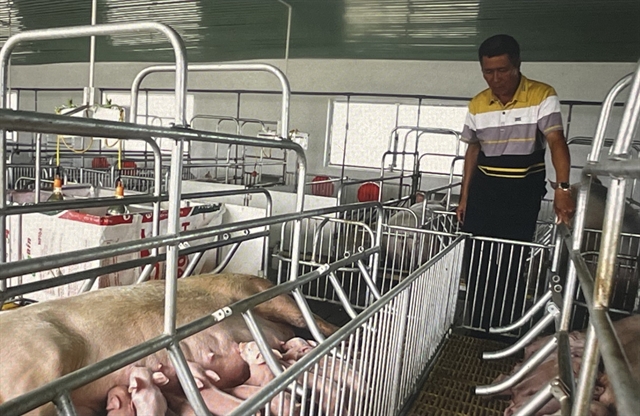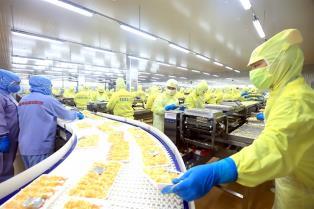VN livestock sector making strong transformation through modern technology
The country’s livestock sector is entering a defining era of transformation powered by modern technology, innovation and sustainable practices.

HCM CITY — The country’s livestock sector is entering a defining era of transformation powered by modern technology, innovation and sustainable practices.
From smallholder farming to industrial-scale production, the industry is rapidly embracing digitalisation and automation to enhance productivity, ensure food safety and strengthen global competitiveness.
Technology, innovation, and digital transformation have become the backbone of sustainable livestock development.
These advances include disease-resistant breeding research, smart barns with automated feeding systems, waste treatment solutions, and early warning mechanisms for disease control.
Many Vietnamese enterprises are leading this technological shift, paving the way for a modern and circular agricultural ecosystem.
One notable example is Hùng Nhơn Group, which began nearly two decades ago as a small poultry farm in the former Bình Phước Province, now part of Đồng Nai.
With a long-term vision, the company has evolved into one of Việt Nam’s leading high-tech agricultural corporations.
“After the early failure of small-scale livestock farming, we decided to collaborate with leading global agricultural corporations such as De Heus from the Netherlands and Belga from Belgium,” Vũ Mạnh Hùng, its chairman, said.
“Through this cooperation, Hùng Nhơn has quickly established its position with a series of international certifications under the Global GAP standards, which include 349 strict criteria.”
Hùng Nhơn has been “a new driving force” for Vietnamese agriculture, introducing sustainable production models and advanced cooperative frameworks, he said.
The first phase of its high-tech livestock zone, which cost VNĐ200 billion (US$8.1 million), has been completed and is now operational.
It has developed a closed, circular agricultural ecosystem covering poultry and pig breeding, organic fertiliser production and antibiotic-free eggs.
Each stage of the production chain employs technologies imported from Germany, Japan and the Netherlands to optimise efficiency and ensure biosecurity and product quality.
Beyond production, it serves as a model of smart, sustainable agriculture in Việt Nam, integrating environmental protection, animal welfare and digital monitoring systems.
With its sustainable strategy and innovative approach, Hùng Nhơn is not only meeting domestic demand but also expanding export opportunities.
It has successfully shipped processed chicken to Japan — a milestone for Việt Nam’s livestock industry on the international stage.

From innovation to high-tech livestock hub
Following its merger with the former Bình Phước Province, Đồng Nai has become one of the country’s major livestock hubs, particularly in pig and poultry production.
It is an early pioneer in adopting modern technology, shifting from small-scale to industrial-scale farms with high productivity and strict safety standards.
Today Đồng Nai’s livestock population ranks among the nation’s largest with around 4.2 million pigs, 36.5 million fowls and over 170,000 head of cattle.
The sector has made major strides in industrialisation, with 92 per cent of pigs and 84 per cent of chickens raised on farms rather than in households.
Cold barns with automated feeding and watering systems house 35 per cent of the total pig and poultry populations.
Some 98 per cent of pigs and 90 per cent of chickens belong to new, high-quality breeds, and almost all large-scale farms have installed efficient waste treatment systems.
According to Nguyễn Văn Thắng, deputy director of the provincial Department of Agriculture and Environment, Đồng Nai has established comprehensive supply chains linking production, processing and consumption to ensure food safety and traceability.
It has six production chains that supply more than 360 million eggs annually, equivalent to 27 per cent of its total egg output, and 10 poultry meat chains producing 143,000 tonnes.
They include Koyu & Unitek Co. Ltd. in Long Bình Ward, which accounts for 22,500 tonnes of the latter.
The company exports around 320 tonnes of processed chicken a month to Japan, equivalent to 780 tonnes of live chickens.
Another major player, CPV Food Co. Ltd., operates a slaughterhouse in Chơn Thành Ward with a capacity of 150,000 chickens per day that supplies 135,000 tonnes of chicken meat annually for both domestic and export markets.
Đồng Nai also has 35 pork production and processing chains, providing around 550,000 tonnes annually, or 65.5 per cent of its total output.
“Livestock production in Đồng Nai contributes significantly to the province’s agricultural value, providing jobs and stable incomes for tens of thousands of workers,” Thắng said.
“It plays an essential role in rural livelihoods, food security and economic growth.”
According to Deputy Minister of Agriculture and Environment Phùng Đức Tiến, the sector needs to maintain strong growth to meet domestic food demand and expand exports.
“In 2025 pig farming alone should target a growth rate of 5.7-5.9 per cent.
“This requires broader adoption of high-tech solutions, biosecure farming, full vaccination coverage, and stronger supply chain linkages to safeguard efficiency and reduce market risks.”
For Việt Nam, investing in science and technology is no longer an option but an imperative for achieving sustainable livestock growth.
It ensures not only productivity and food safety but also long-term competitiveness in the global market.
As the nation accelerates its digital transformation, innovation remains the key to unlocking a new era of resilient, high-value and sustainable agriculture. — VNS





